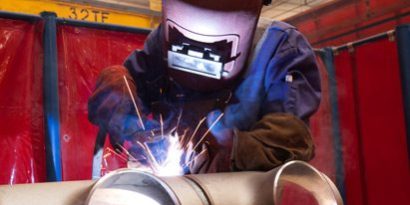Check out this basic guide to learn about the fascinating field of welding. Welding is an intriguing fusion of science and practical craftsmanship, whether you’re preparing for an extensive welding training program or just curious to learn more as a hobby.
Learn about the fundamentals of welding, its operation, typical welding equipment, and how Summit College can provide you with practical welding instruction.
The Reason for Welding
The fundamental goal of welding is to firmly fuse two components together. Welders usually work with thermoplastic or metal, binding them together with a durable filler material. Many of the contemporary buildings in our world, including cars, ships, airplanes, and skyscrapers, are made with welding.
Previously, builders joined metal workpieces in different ways. There are three alternatives to welding: brazing, riveting, and soldering. Find out why welding is so highly valued in manufacturing and industrial applications, and why it has become the standard joining option for many industries.
Fundamentals of Welding
When two materials are joined together using welding, no additional binder material is needed. Welding joins the two workpieces directly together, as opposed to brazing and soldering, which use a binder with a lower melting point. Knowing this distinction is essential to comprehending welding and the reasons it is the material of choice for strong, long-lasting construction.
Common Welding Types
There are three primary welding techniques, so it’s critical to comprehend each one as well as the weld material’s strength for your intended use. The three fundamental welding methods that contemporary welders can use are as follows:
Welding gas
Welding with arcs
laser-based joining
An electrical arc is used in arc welding to melt work material. A grounding wire is first fastened to the substance. The welder then presses an electrode lead up against the material to be joined. An electric arc, also referred to as a continuous plasma discharge from the electrical breakdown of gas, is produced as the welder pulls the electrode away from the material. Arc welders create a very narrow, concentrated weld point using either AC or DC power.
Gas welding is yet another popular kind of welding. This is an older and more popular option that is also referred to as oxy-fuel welding. A welding stick, also known as a point of focus, is filled with gas and ignited to produce a high-temperature flame. It works well with high-alloy steels. The weld point is much hotter and better suited for extremely tough alloys even though it is less concentrated than with electric welding.
The most recent advancement in welding technology is laser welding. At the moment, only extensive industrial applications employ this technique. High-energy beams are used by laser welders to fuse materials together. It’s an expensive system that needs to be handled with skill and delicacy.
Advantages of Welding
There are several advantages to welding over other joining techniques. Several industrial construction processes combine materials through welding for the following reasons, to name a few:
• Strong connection
• Perfect stitching
• Higher melting point
• Versatile and effective system
The Equipment Used in the Trade
Find out what you need to do to get ready for a welding career. These are the essential tools and supplies you’ll need to start off as a welder.
The proper setting and safety gear are required before you operate any kind of welder. Extreme heat, sparks, and slag made of metal are released during welding. Wearing protective clothes while working is crucial to preventing burns. Your eyes are shielded from the intense light of the welder by a welding mask. High temperatures produce light that is so intense that it can cause eye damage.
There is an overwhelming amount of variation in welder tools. To choose the ideal welder type for you, carefully weigh your options and consider the application you want to use. Ask your instructor about the best welder for beginners if you’re undergoing welding training. Consider the following common types of welders:
• Stick welding or shielded metal arc welding (SMAW)
Welding with a gas metal arc, also known as MIG welding
• Arc welding submerged (SAW)
• TIG welding, also known as gas tungsten arc welding,
The ideal welder for your job depends on your metal and the kind of weld you want to accomplish. Large, structural welds are a better fit for some welders, while intricate, surface welds that are simple to buff to a perfect finish work best for others.
Scriven Precision Fabricating In Chandler, AZ
Scriven Precision Fabricating specializes in the production of electronic chassis and related components. We provide quality product within a .005 tolerance if needed. We also pride ourselves with dependable deliveries. Our 13,500-square-foot facility located in Chandler, Arizona, has the most modern CNC punching equipment available. Contact our experienced team today!


